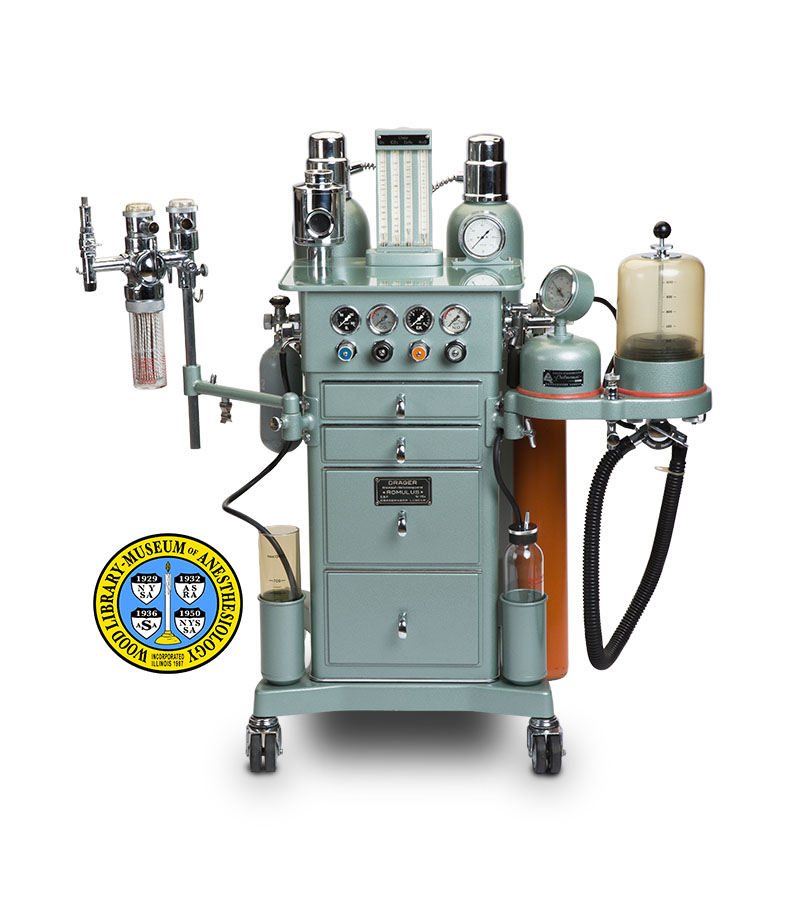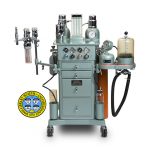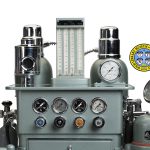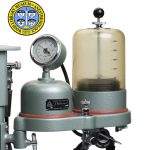Draeger Romulus
Based in Lubeck, Germany, Draeger has been one of the world's leading makers of anesthesia and respiratory therapy equipment for over a century. The company introduced its Romulus anesthesia machine in 1952. It was one of many Draeger machines named for famous figures of mythology and history. According to legend, the twin brothers Romulus and Remus founded the city of Rome in the 8th century BCE. The Romulus machine was the first Draeger model made in the cabinet style. Its features included positive-pressure gas delivery, carbon dioxide absorption, a suction bottle, and the company's first bubble-through ether vaporizer. The example shown here could deliver ether, nitrous oxide, carbon dioxide, cyclopropane and oxygen. It is equipped with the Draeger Pulmomat anesthesia ventilator, which was introduced in the same year.
This machine was acquired from the Horst Stoeckel Museum for the History of Anesthesiology, in Venusberg (Bonn), Germany.
Catalog Record: Draeger Romulus Draeger Romulus
Access Key: aqko
Accession No.: 1999-07-23-1
Title: Draeger Romulus / Draeger.
Corporate Author: Draeger.
Publisher: Lubeck, Germany : Draeger, [between 1952 and ca. 1980].
Physical Description: 1 anesthesia machine : metals, plastics, glass, rubber, leather ; 114.5 x 130 x 117 cm.
Subject: Anesthesia, Inhalation – instrumentation.
Subject: Anesthesia Machines.
Subject: Ether, Ethyl.
Subject: Nitrous Oxide.
Subject: Carbon Dioxide.
Subject: Cyclopropane.
Subject: Oxygen.
Note Type: General
Notes: The first year in the date range is the year that this model was introduced. The second year in the date range is based on the latest contemporary publication found by the cataloger.
Described with the flowmeters and drawers facing forward.
Note Type: With
Notes: Received, and photographed, with a small carbon dioxide cylinder attached to the CO2 connector. Other parts were found in the drawers.
Note Type: Citation
Notes: Draeger. The History of Anaesthesia at Draeger. Lubeck, Germany: Draeger, 1996:47-49, and 53-55.
Note Type: Citation
Notes: Draeger. Pulmomat. Lubeck, Germany: Draeger, 1967. In: Draeger Company File. Archives. Located at: Wood Library-Museum of Anesthesiology, Schaumburg, Illinois.
Note Type: Citation
Notes: Draeger Company File. Archives. Located at: Wood Library-Museum of Anesthesiology, Schaumburg, Illinois.
Note Type: Citation
Notes: Goerig M. Anesthetic Equipment in the History of German Anesthesia: Catalogue of the exhibition held at the Museum fur Kunst und Gewerbe, Hamburg, from 23 April to 4 May 1997 on the occasion of the German Congress of Anesthesiology and the Fourth International Symposium on the History of Anesthesia. Lubeck: Draeger, 1997:102.
Note Type: Citation
Notes: Haupt J. Draeger Anaesthetic Apparatus, An Historical Survey 1900-1970. Lubeck: Draeger, 1970:18-20.
Note Type: Citation
Notes: Schreiber P. Anaesthesia Equipment: Performance, Classification and Safety. Berlin: Springer-Verlag, 1972:187.
Note Type: Physical Description
Notes: One anesthesia machine; The metal housing has a light green metallic enamel; The base of the cabinet holds double, rubber wheels at each corner; The dimensions given in the short description are the maximum dimensions with the armatures extended fully either to the front (depth) or to the sides (width);
Near the center of the back edge of the tabletop there is a bank of four flowmeters; This is marked: “l/min [new line] O2, CO2, C3H6, N2O”; At the far left, the oxygen flowmeter is marked, from top to bottom: “5, 4, 3, 2, 1, 0.8, 0.6, 0.4, 0.2”; To the right of this, the carbon dioxide flowmeter is marked, from top to bottom: “1.2, 1, 0.8, 0.6, 0.4, 0.2, 0.1, 0.005”; To the right of this, the cyclopropane flowmeter is marked, from top to bottom: “0.8, 0.7, 0.6, 0.5, 0.4, 0.3, 0.2, 0.1, 0.005”; On the far right, the nitrous oxide flowmeter is marked, from top to bottom: “12, 10, 8, 6, 4, 3, 2, 1, 0.5”;
Seated on the left rear corner of the tabletop is a raised metal ring that holds the removable carbon dioxide absorber; The interior of the ring does not in any way communicate with the interior of the apparatus; A pressure gauge is seated on the right rear corner of the tabletop; This gauge is marked, from left to right: “0, 50, 100, 150, 200, 250, 300 [new line] mmHg [new line] [Draeger logo]”;
On the front of the cabinet, below the tabletop, there is a horizontal row of four gauges; At the far left is a black gauge marked in white: “0, 100, 200, 300 [new line] kg/cm2 [new line] O2”; To the right of this is a white gauge marked in black: “0, 50, 100, 150, [new line] kg/cm2 [new line] CO2”; To the right of this is a black gauge marked in white: “0, 5, 10, 15 [new line] kg/cm2 [new line] C3H6; At the far right is a white gauge marked in black: “0, 50, 100, 150 [new line] kg/cm2 [new line] N2O”;
Below the oxygen gauge on the far left is a control knob that is colored blue; Below the carbon dioxide gauge is a control knob that is colored black; Below the cyclopropane gauge is a control knob that is colored orange; Below the nitrous oxide gauge on the far right is a control knob that is colored with two black concentric rings; Below these controls, the cabinet has four drawers; The top two drawers are shallow and the lower two drawers are deep; A label plate on the front of the third drawer reads: “DRÄGER [new line] Kreislauf Narkoseapparat [new line] ROMULUS [new line] D.B.P. Nr. 1154 [new line] DRÄGERWERK LUBECK”;
A bracket is mounted on the left wall of the machine, near the bottom front edge; This bracket holds a transparent plastic tube that is round on the bottom and open at the top; This tube is marked, from top to bottom: “Max, 134° C, 700, 600, 500, 400, 300, 200, 100, [Draeger logo], 10”;
A bracket extends from the left wall of the machine, near the tabletop; The horizontal arm of this bracket holds three components; These components are: on the left, a cylindrical gauge, marked in two vertical rows; That row on the left is marked, from top to bottom: “Cm, 5, 15, 25”; That row on the right is marked, from top to bottom: “H2O, 1, 10, 20”; These markings are repeated on the back of this component; In the center, a glass ether vaporizer; The bottle is marked in white: “GRAMM ÄTHER”, and below this it is marked in red, from top to bottom: “100 [new line] 50″; These markings are repeated twice; A metal control ring on the front of the bottle is marked, from left to right: :”0, 1, 2, 3, 4”; on the right, an additional pop-off valve; A horizontal row of three connectors are mounted on the left wall of the machine, below the tabletop; From front to back, these are: one labeled “Gasgemisch” (i.e. gas mixer), one labeled “O2”, and one labeled “CO2”;
Note Type: Physical Description
Notes: A bracket extends from the right wall of the machine, near the front edge; This bracket holds the ventilator; The ventilator consists of two three components mounted on a horizontal platform; That component on the left is squat metal dome with a pressure gauge mounted on top; This gauge is marked, from left to right: “-30, 20, 10, 0, 20, 40,60, +80 [new line] cm WS”; A black rubber hose runs from the back of this gauge to the interior of the platform; A label plate on this dome reads: “[Draeger logo] NARKOSE BEATMUNGSGERAT [new line] PULMOMAT [new line] D-B-P. FABR. NR. 1134 [new line] M7694 [new line] DRAEGERWERKE LUBECK”; That component in the center of the platform is a dial mounted on a short, vertical, metal shaft; This dial is marked: “mehr [left and right arrows] wenger”; That component on the right is a tall, transparent plastic dome that holds the ventilator bellows; From top to bottom, this dome is marked: “1000, 800, 400, 200, 100, 50, cm3”; A metal rod extends from the top of the dome, with a black plastic knob at the top and a black disc at the bottom; This rod can be lifted or lowered manually, but when at rest the disc sits on top of the bellows; This disc carries a metal flange; Below the platform, under dome containing the bellows, there is a disc labeled: “Pulmomat Atembeutel” (i.e. breathing bag); A corrugated black rubber hose is connected to the left side of this disc at one end, and to the right side of the same disc at the other end;
Three components are mounted on the right wall of the machine, below the tabletop; From front to back these are: a connector labeled “Absaugen” (i.e. suction; a black rubber hose extends from this connector to the suction bottle, below), a connector labeled “N2O”, and a cylinder yoke labeled “C3H6”; Another bracket is mounted on the right wall of the machine, near the bottom front edge; This bracket holds a transparent plastic capsule with a connector in the top; A black rubber hose is attached to this connector; The capsule is marked with a red line and the word “Maximum”, also printed in red;
The back of the machine has two connectors near the tabletop; That on the left is labeled “N2O” and that on the right is labeled “O2”; Coiled metal hoses extend from these connectors; Each of these hoses ends in another connector; Below these, near the base of the machine, is a platform that can hold two large compressed gas cylinders; This platform is occupied by parts intended to cover and to connect such tanks to the machine; An enameled metal sleeve and separate shoe would cover each cylinder; Each is topped by a chrome cap with a notch to accommodate the connector; These metal sleeves are held in place by a leather strap.
Note Type: Reproduction
Notes: Photographed by Mr. Steve Donisch, June 21, 2017.
Note Type: Acquisition
Notes: Acquired from the Horst Stoeckel Museum for the History of Anesthesiology, Bonn, Germany.
Note Type: Historical
Notes: Based in Lubeck, Germany, Draeger has been one of the world’s leading makers of anesthesia equipment since 1902. Fifty years after its first apparatus, the company introduced the Romulus anesthesia machine. This was the first of many Draeger models named for famous figures of mythology and history. According to legend, the twin brothers Romulus and Remus founded the city of Rome in the 8th century BCE. (Draeger introduced its Remus machine in 1970.) The Romulus was the first Draeger machine produced in the cabinet style. It combined the positive-pressure delivery of the Draeger MÜ model (introduced in 1935), the carbon dioxide absorption system and suction bottle of the Model F (introduced in 1948), and the flowmeter bank of the Model G (introduced in 1950), together with
Draeger’s first bubble-through ether vaporizer and other improvements. The cataloged object could deliver ether, nitrous oxide, carbon dioxide, cyclopropane and oxygen.
In addition to anesthesia apparatus, Draeger is also noted for its respiratory equipment. The best known of these was the Pulmotor resuscitator. Introduced in 1907, various models of the Pulmotor remained in use into the 1940s, and were copied by numerous other manufacturers. Despite this long popularity, its clinical value was debated. Further developments of this apparatus led to the introduction of the Draeger Pulmomat anesthesia ventilator in 1952. The cataloged object is equipped with a Pulmomat, which was an optional feature. Romulus models were produced as late as the 1970s.
Note Type: Exhibition
Notes: Selected for the WLM website.




